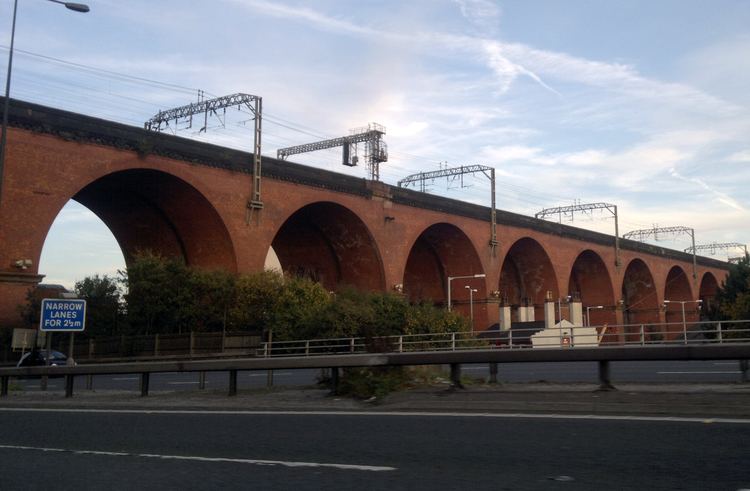Country England Structural system Masonry arch Cost 70,000 GBP Engineer George W. Buck | Completed 1840 Opened 4 June 1840 Construction started 1839 | |
 | ||
Similar | ||
45690 leander over the stockport viaduct on the east yorkshireman
Stockport Viaduct is a large brick-built bridge which carries the West Coast Main Line across the valley of the River Mersey, in Stockport, Greater Manchester (grid reference SJ89089030).
Contents
- 45690 leander over the stockport viaduct on the east yorkshireman
- Stockport viaduct by train
- History
- Stockport Rail Accident 1948
- References
It is the largest brick structure in the United Kingdom and was designed by George Watson Buck for the Manchester and Birmingham Railway and completed in 1840. The viaduct is 33.85 metres (111.1 ft) high. At the time of its construction it was the largest viaduct in the world, and it represents a major feat of Victorian engineering and a key pioneering structure of the railway age. It is currently a Grade II* listed structure, and remains one of the world's biggest brick structures.
The M60 motorway passes through two of the viaduct's arches between Junction 1 (A5145 road) and Junction 27 (Portwood Roundabout).
Stockport viaduct by train
History
The 27 arch viaduct took 21 months to build and cost £70,000; 11,000,000 bricks were used in its construction. It was officially opened on 4 June 1840. In common with Stockport railway station, the viaduct was also historically referred to as Edgeley Viaduct. At the peak of the work, 600 workers were employed in shifts – working day and night – to complete the structure. It was entirely built of layer upon layer of common brick. The engine house of the 1831 Wear Mill lay on the path of the viaduct- so the viaduct was built over it. The viaduct opened in 1842 with services running to Crewe, allowing passengers from Stockport to reach London.
It has made a brief contribution to literature, being mentioned in the introduction to the Northern Mill Towns in Elizabeth Gaskell's North and South.
The first section of the Manchester & Birmingham line to be completed ran from a temporary station in Manchester, at Travis Street, to a temporary station at Heaton Norris, on the Lancashire side of the Stockport viaduct. Opened for traffic on 4 June 1840, this short line was an immediate success, carrying nearly 2,000 passengers a day during the second half of 1840. Two years later, on 10 May 1842, train services were extended from Heaton Norris to Sandbach and the permanent Manchester station in Store Street was opened.
In around 1890 it was decided the viaduct should be expanded. This was because London and North Western Railway, formed in 1846, wanted to have several tracks on one route so that slower trains could be overtaken. To add more tracks to the viaduct would mean the need for expansion. The viaduct was expanded to accommodate four tracks instead of two. The viaduct has appeared in several of L.S. Lowry's works.
The overhead power cables were added during the 1960s when this part of the West Coast Main Line was electrified.
The viaduct underwent a programme of restoration in 1989, costing £3 million. The process included adding floodlights to the structure. The viaduct is now part of a main line service carrying passengers to destinations across the UK.
In 2007 Stockport council complained about plans by the train operator CrossCountry to reduce by 50% the number of Manchester to Birmingham trains stopping at Stockport. Councillor David White claimed that an 1840 Act of Parliament guaranteed that all trains passing over the viaduct had to stop at Stockport station. However, the local MP Andrew Gwynne states on his web page "Sadly no such Act of Parliament exists, although it is common currency in the town that it does. I made enquiries with the House of Commons Library and the Parliamentary Archives back at the time some intercity trains stopped using Stockport. It appears it is purely an 'urban myth'."
In 2011, Stockport Viaduct was refurbished by Network Rail.
Stockport Rail Accident 1948
The Stockport Viaduct was the scene of a rail accident on 30 November 1948 at approx 19:40 when in the darkness and in thick fog a combined Buxton Service ran into the back of a combined Crewe and Disley service that was stopped at the signal at the south of the viaduct waiting for a platform. Although the collision was only at 10-15 mph because of the inertial mass of the four locomotives the last (11th) coach of the Crewe/ Disley service telescoped into the tenth carriage. Five people lost their lives and there were 27 serious casualties. The impact point was approximately in the centre of the viaduct. The Inspector attributed the cause of the accident to the driver of the lead engine of the Buxton train, which was stopped at a signal just south of Heaton Norris railway station (now closed) misinterpreting a shout from the Assistant Porter as a shout from the Guard as permission to proceed, which the Guard should have obtained from the signal box under Rule 55; as the signal not being visible in the dense fog: The train therefore passed the signal at danger.
